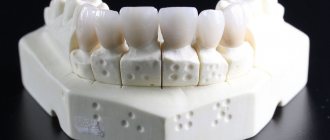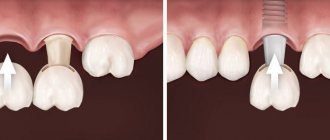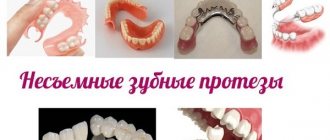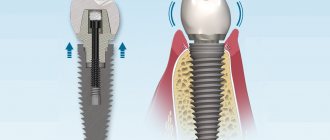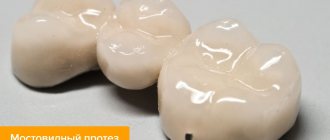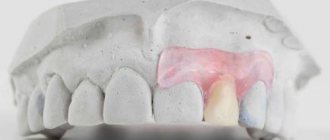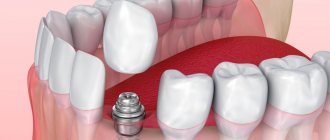A bridge on implants is a reasonable option for prosthetics in case of loss from 3 teeth to their complete absence. Cheaper than implantation of each lost tooth, more reliable than bridge prosthetics on your own teeth.
In our Center they are installed after computer diagnostics and bite examination, and are manufactured in our own dental laboratory. A lifetime warranty is provided for implants in our Center, and 25 years for metal-free crowns as part of a bridge.
A dental bridge on implants is a non-removable orthopedic structure made from welded crowns to restore several teeth in a row.
- Difference from traditional bridges The bridge is supported not by your own teeth, but by pre-installed implants. There is no need to grind down the enamel of adjacent healthy teeth.
- Difference from classical implantation Each tooth does not require a separate implant; fewer are installed. And the bridge includes crowns for each tooth. Allows you to save money.
Bridge prosthesis on implants
Advantages
If you lose several teeth in a row, dental bridges on implants are the right solution. Allows you to correctly distribute the load and not use healthy teeth.
- Neighboring teeth do not deteriorate. The supports are implants implanted into the jaw, and not your own teeth, which must be ground down.
- Durability Implants last a lifetime, and the service life of the prosthesis is at least twice as long as that of classic bridges.
- Aesthetics Crowns are no different from your own teeth. The aesthetic gingival contour is recreated.
- Affordability Savings compared to classic implantation, when each tooth is replaced with an implant and a crown.
What are dental implants
Implant-supported prosthetics differs from classical prosthetic technology. The method is based on the rehabilitation of the dentition without the involvement of healthy units. Instead of a missing or non-viable tooth, a separate implant is implanted - a titanium root that imitates a natural one, onto which an orthopedic structure (crown, bridge, complete denture) is fixed. With the help of dental implants, any number of units can be restored - from 1 to all in a row.
Is it always possible to put a bridge on implants?
A bridge prosthesis on implants is suitable in any clinical situation, regardless of the extent and location of the defect in the jaw
Installed when:
- loss of three adjacent teeth in a row; with fewer teeth there is no need
- absence of outer teeth in a row , when there is no support on one side for a conventional bridge
- complete edentia , when there are absolutely no supports for fixation for a traditional bridge
Bridges on implants do not require grinding of adjacent teeth.
They are used even in cases of terminal defects and complete edentia, which cannot be achieved with traditional bridge prosthetics. Another undoubted advantage is that there is no need to prepare the enamel of neighboring teeth, which means they will remain healthy and last longer.
Levin Dmitry Valerievich Chief physician and founder of the Doctor Levin center
Disadvantages of technology
The disadvantages of bridges on implants include:
- the need to have implants: for many patients this fact is frightening. They are worried that a foreign body will have to be implanted into the jaw bone, and they will have to decide on the implantation procedure itself. However, there is no need to be afraid, because... Modern methods of treatment and restoration of teeth make it possible to carry out all manipulations with minimal risk and discomfort for the patient. The implantation period is preceded by a thorough preparatory stage; the doctor pre-works out each step in 3D visualization and computer programs, taking into account the data from a computed tomography scan of the jaw of a particular patient. The specialist also creates unique surgical guide stencils, through which he installs artificial roots into the bone in a minimally invasive way,
- the possibility of resorption of bone tissue under the bridge and its atrophy: if only a few artificial roots were installed on implants as support for a classic bridge, then the bone at the site of the prosthesis itself may be subject to atrophy. But in this case, thinning will occur much more slowly than if a removable denture was chosen,
- high cost compared to bridge structures, where living teeth act as support: but take into account the fact that the natural supports in this case will wear out very quickly, which will affect both the quality of the structure itself and discomfort during its operation. And after such prosthetics, it is likely that you will have to think about restoring a larger number of teeth than previously planned.
How many implants are needed for partially missing teeth?
When calculating the number of implants, we take into account the distribution of chewing load
The load on the jaw when chewing should be uniform so that there is no subsidence of the gums and bone tissue under the hinged crowns. This will ensure the durability of the prosthesis and maintain aesthetics. Therefore, fixing a bridge on 2 implants is not always the right solution. It is recommended to use a 1:2 calculation - one implant for 2 crowns . Accordingly, the more teeth are missing, the more implants will be needed.
1-2 teeth missing
In this situation, bridges supported by implants are not relevant; teeth are restored separately. Each one has its own implant, which is covered with a separate crown. In this case, it is not recommended to combine crowns - if one is damaged, you will have to remove two at once. No 3 teeth
The most common clinical picture.
If there are no three adjacent teeth in a row, 2 implants are implanted along the edges of the defect, and a prosthesis for 3 teeth in the form of interconnected crowns is fixed on them. The outer ones are mounted on supports, and the middle one is hinged. You can install three implants, but this solution is cheaper. 4 missing teeth
When installing a bridge on 4 missing teeth in a row, the number of supports increases to three, and the number of crowns increases to four.
If you use two supports, then there will also be two mounted crowns. Atrophy of the jaw bone under the prosthesis cannot be ruled out due to uneven load. And the risk of prosthesis breakage increases due to increased pressure on the central part. No 5 teeth
Bridge prosthetics on implants is possible for 5 teeth or more.
If five teeth are missing, three implants are needed. If a bridge of 6 teeth or more is required, three supports are used - the number is calculated by the number of crowns in the structure. The degree of future load and its distribution on the bone tissue are taken into account to prevent atrophy.
How to install
As with other types of prosthetics, before installing bridges on implants, doctors study the individual anatomical characteristics of the patient and prepare him for the procedure. All existing dental diseases are treated and active inflammatory processes are eliminated. To study the bone tissue, a computed tomography scan of the jaw is done. If necessary, the patient has bone tissue augmented.
Next, the implants are installed. It can be done in two ways.
In one visit: immediately after implantation of the rod, a temporary or permanent prosthetic structure is fixed onto it. This approach is typical for one-stage implantation methods. In particular, this is how dental prosthetics are performed on 4 implants, the cost of which starts from 200 thousand rubles including the prosthesis. And also on three, six implants or using basal models.
In two stages: after implantation, they “cover” the rod with gum and wait for its complete engraftment, which will take from 3 to 8 months. Only then can you begin permanent prosthetics.
Full bridges for the lower and upper jaw
In case of complete edentia, fixed bridge structures are reinforced with a metal arch
The arch unites the crowns, increases the strength of the bridge and allows it to withstand severe chewing loads. The number of implants is determined depending on the clinical picture, anatomical features and jaw size.
- In the upper jaw, bone tissue has a lower density, therefore, during implantation, a larger number of implants are used - 8 pieces.
- On the bottom , on the contrary, the bone is denser, so 6 implants are enough for complete prosthetics. This is subject to standard jaw sizes. If the patient has a large jaw, two more implants are added to evenly distribute the load and ensure safe operation of the prosthesis.
A dental bridge with 6 implants is usually solid, but a denture with 8 implants can be made segmented - from four sections. This is a more convenient option - if necessary, you can remove only one segment, and not the entire prosthesis.
Also, in case of complete absence of teeth, the All-on-4 and All-on-6 protocols are used. 4 or 6 implants are installed on one jaw in a certain way, observing the principles of load distribution. Immediately on the day of implantation, a temporary non-removable adaptive prosthesis is installed, and after 6 months it is replaced with a permanent one.
Attaching a bridge to implants
You can attach a dental bridge to implants using a screw: the dental crown is immediately connected to the abutment, and then screwed with a screw to a titanium rod through a small hole in the crown. It is then masked using filling material.
Or using dental cement: the finished bridge is fixed to the abutment attached to the implant using a special cement composition. It is not possible to remove such a structure - you just need to saw it.
What materials are they made of?
Dentures are manufactured in the Center’s own dental laboratory, you can choose the appropriate option to suit your taste and budget
- Metal-ceramic The base of the crowns is a metal alloy, the top is covered with ceramic mass. Relatively inexpensive, yet durable and quite aesthetic. The main disadvantage of metal ceramics is the ability to oxidize and cause a bluish outline to appear on the gums over time. Service life - 15 years or more .
- Zirconium Can be all-zirconium or coated with ceramics. They can withstand any load, do not deform, and retain their original appearance. Identical to natural teeth, the shade is selected individually. More expensive than metal-ceramic ones, but last longer. Service life - 25 years or more.
We offer patients the most profitable and practical methods, so we reserve the advantage for metal-free structures. In our Center, dental bridges are created in our own digital production using Zirkonzahn Schule technology or at the PROCERA (Nobel Biocare) plant in Sweden.
History of the All-on-3 protocol
All-on-3 or Trefoil is not a new technology. It appeared more than 15 years ago under the name “Branemark Novum”. The difference between the current technology and its predecessor is, in fact, only in one thing - then the implants had to be installed strictly vertically, and the implant surgeon had no right to even a slight error - deviations from the norm led to breakage of the screws and loosening of the entire structure.
As a result, it was decided to abandon the technology. But throughout this time, Nobel carried out its refinement and numerous studies. As a result, a beam was created with a special fixation mechanism, which made it possible to slightly change the angle of inclination of the implants without damaging the entire system. Without losing the strength of the entire system.
The Trefoil system in an updated version was introduced in 2015, but began to be used in Russia only in 2021.
Stages of installing a bridge on implants
The process includes several stages - diagnostic, surgical and orthopedic
Diagnostics and planning
Computer diagnostics are carried out, the data is necessary to assess the quality of bone tissue, and is used for virtual planning of the operation. In case of extended defects and complete absence of teeth, a bite examination is performed on an articulator so that after prosthetics the correct closure of the jaws is maintained. The treatment plan is drawn up by the orthopedist - he is the one who coordinates the work of the implantologist, determines the positioning points and the number of implants, taking into account future loads.
Implantation
During the operation, a calculated number of implants are implanted into the jaw. When bone tissue atrophies, osteoplasty is performed - bone tissue augmentation. This is necessary to create reliable fixation of the implants. We work only with premium Nobel Biocare systems and use original prosthetics . For anxious patients with cardiac problems, the possibility of surgery in medicated sleep is provided.
Temporary prosthetics
It will not be possible to install a permanent prosthesis immediately after implantation - you cannot create a strong load so as not to disturb the position of the implants. But you will never leave our Center without an orthopedic solution. On the same day, we will manufacture and install a temporary bridge from lightweight materials, which will hide the defect and last 2-4 or 6 months while the implants take root.
Permanent prosthetics
Permanent bridges are made after fittings and prototyping, taking into account the bite. Installed using transocclusal (screw) fixation. Unlike cement fixation, which is practiced in some clinics, the bridge, if necessary, can be removed without damaging the abutments (the connecting link between the implant and the prosthesis).
Indications and restrictions
| Indications | Contraindications to implantation |
| End defects | Mental illness |
| Unsatisfactory condition of the outer teeth | Somatic pathologies in the decompensated stage |
| Segmental row defects | Endocrine disorders, oncopathologies |
| Multiple edentia (absence of more than half of the units) | Acute infectious diseases |
| Complete absence of teeth | Acute inflammatory processes in the oral cavity |
Bridge on implants or your own teeth - comparison
Each type of prosthetics has its own indications, advantages and disadvantages.
| Tooth-supported bridges | Implant-supported bridges |
| Prosthetic options Up to 3-4 teeth, not suitable for end defects | Prosthetic options From 3 teeth in a row to complete absence |
| Grinding of adjacent teeth is required | Grinding of adjacent teeth Not required |
| Reliability of fastening Possible tooth mobility due to periodontal diseases and inflammation | Reliability of fastening Complete stability due to the fusion of implants with the jaw bone tissue |
| Probability of bone atrophy High - the bone in the area of the defect dissolves and decreases without load | Probability of bone atrophy Low - the load on the bone is uniform due to the installation of the required number of implants |
| Service life Up to 7 years, depending on the condition of the supporting teeth | Service life of a prosthesis - from 15 years, implants - a lifetime |
| Price Lower - costs only for prosthetics | Price Higher - the cost of implantation is added |
In all respects, bridges on implants are superior , the only drawback is the cost in financial and time terms. First, implantation is performed, which requires additional costs and time.
A permanent bridge can be installed only after the implants have healed in order to avoid their displacement during chewing. But this does not mean that you will be left without teeth during this period. Immediately after the operation, we will make a temporary prosthesis that will last until the permanent one is installed and will hide the work performed. You will never leave our Center without teeth!
Similarities and differences
The question of which is better, an implant or a bridge, is decided on an individual basis. The doctor needs to assess the condition of the patient’s oral cavity, collect a detailed history, and carry out the necessary diagnostic measures. Only after this will he be able to offer him one or another prosthetic option.
A dental bridge is a structure of two crowns with artificial teeth between them. A modern implant exactly replicates the root of the natural tooth, onto which the crown is fixed. The similarities between these types of prosthetics include their main tasks: they help restore the aesthetics of the dentition and preserve the functions of the jaw (effective to varying degrees).
There are many more differences between the methods, including:
- Price. Bridges are more affordable than implants.
- Duration of installation/manufacturing. It will take 10–14 days to manufacture and fix the bridge. The fabrication, implantation, engraftment of an artificial root, as well as the installation of a permanent crown can take months.
- The need for surgery. Surgery is required to fix the implants. For bridges, only grinding of the supporting teeth is necessary.
- Load distribution. Implants allow you to properly distribute the chewing load and preserve your natural teeth. Bridges distribute the load incorrectly, which can lead to negative consequences for the patient.
Each method has its own strengths and weaknesses.
Service life of bridges on implants
Implant-supported bridges have increased stability compared to bridges supported on your own teeth. The period of operation does not depend on the condition of the supporting teeth, which over time can become loose from increased loads.
Implants create a uniform load on the bone tissue, eliminating subsidence of the bone under the prosthesis, thereby extending the service life of the structure. Metal-ceramic dentures last from 10 years, zirconium – from 25 years.
a 25-year guarantee on metal-free crowns supported by implants . The Center's warranty on the implants themselves . We use only premium Nobel Biocare implant systems and original prosthetics.
Main differences from protocols on four and six implants
The main difference is the number of implants (due to this, it was possible to significantly reduce the cost of implantation), as well as the absence of an adaptive prosthesis. In addition, a beam with a unique fastening mechanism is separated into a separate element.
The design of the beam is designed in such a way as to repeat the smooth bend of the lower jaw, protect the mucous membrane from damage, and also compensate for vertical or horizontal deviations of the implant, subject to immediate loading with the prosthesis. In addition, the bar extends beyond the boundaries of the two outermost implants, which makes it possible to attach a prosthesis consisting of a maximum of 12 crowns in a row to it. In protocols for four or six implants, the prosthesis has a similar strong connecting frame, but it is developed strictly individually for the patient, since the doctor is not working with a parallel bone ridge at all.
Expert opinion
Bespalov Roman Dmitrievich Maxillofacial surgeon, implantologist Work experience 25+
“If methods on four and six implants have already been developed over the years of use both around the world and in Russia, then the Trefoil concept may cause some mistrust. But patients do not need to be afraid, they need to cast aside all doubts, because this is a treatment protocol that was developed by Nobel, the founder of all dental implantation. Almost 15 years of work, more than 300 clinical studies. This protocol, if you follow all the recommendations and strictly follow the original concept, simply cannot be bad. Now it has very harmoniously integrated into the complex of immediate loading methods and allows us to give our patients even more opportunities to live a full life.”
What does the cost consist of?
Our Center provides a case payment system
The implant installation case includes:
- local anesthesia;
- cost of the Nobel Biocare implant and its installation;
- consumables and superstructures;
- applying and removing sutures;
- control CT diagnostics after surgery.
The case for installing a bridge includes:
- taking impressions;
- production of prosthesis;
- fitting and fixation of the structure.
Paid separately:
- Diagnostic case before implantation - the cost depends on the necessary studies.
- Osteoplastic surgery if necessary - the price is calculated depending on the type of bone augmentation and the duration of the defect.
- Sedation - calculated for each hour spent in medicated sleep. Usually 1 hour is enough to install 2-3 implants.
The total cost of bridge prosthetics on implants is formed taking into account:
- length of the defect;
- type and number of implants;
- number of crowns in the structure;
- the need for osteoplasty;
- use of sedation.
Cost* of MOTOR TOOTH IMPLANTATION in dentistry Partner-Med
| Name of dental service | Price* in rubles for cash |
| Implantation ASTRA TECH ALL INCLUSIVE TURNKEY (implant+crown+abutment+work) | 72 000 ₽ |
| Implantation ASTRA TECH TURNKEY PROMOTION (implant + metal-ceramic crown + abutment + work) | 69 900 ₽ |
| Implantation ASTRA TECH TURNKEY PROMOTION (implant + zirconium oxide crown + abutment + work) | 74 000 ₽ |
| Implantation OSSTEM TURNKEY PROMOTION (implant+zirconium dioxide crown+abutment+work) | 49 900 ₽ |
| ASTRA TECH implant installation (complicated) | 44 000 ₽ |
| Implantation OSSTEM PROMOTION (implant + metal-ceramic crown + abutment + work) | 42 000 ₽ |
| Implantation IMPRO ALL INCLUSIVE PROMOTION (implant + abutment + metal-ceramic crown + work) | 39 990 ₽ |
| Implantation OSSTEM PROMOTION (implant + zirconium dioxide crown + abutment + work) | 49 900 ₽ |
*The indicated cost of the service is valid as of March 2021 for patients visiting our clinic for the first time. Please check the current cost with individual prices available for you by calling + 7
Just CALL US!
+7
We will answer any of your questions and will definitely help you!
Dental bridge materials
The bridge structure has excellent quality characteristics, and the material from which the crowns are made is of considerable importance, which largely determines the duration of the operational period of the prosthesis.
Metal-ceramic dental bridge
- The choice of metal-ceramics for creating permanent bridge structures in most clinical cases is the best option in terms of price: quality ratio.
- Thanks to a single solid metal frame, such crowns are very durable, and the outer coating of the crown with a ceramic layer gives it a completely aesthetic appearance.
- The use of metal-ceramics is not limited by the number of teeth, and the duration of the functional period is up to 15 years.
- The technology for manufacturing a metal-ceramic crown makes it possible to accurately reproduce the anatomy of the surface of an artificial tooth and provide it with a functional load.
Plastic dental bridge
- Metal-plastic bridges are widely used due to their economy and lightweight design, which has a metal base lined with a layer of special plastic with a gingival base.
- However, due to the significantly short service life (no more than 3-5 years), such prostheses are often recommended for use during the period of adaptation.
- Metal-plastic structures make it possible to quickly carry out a simple procedure for correcting the bite and are the best option for temporary prosthetics.
Zirconium dioxide dental bridge
- Zirconium dioxide is a light-colored metal from which the frame of the future structure is made, followed by layer-by-layer application of ceramic mass.
- It is not recommended to make bridges with a zirconium dioxide frame in conditions of complete edentia (horseshoe-shaped prosthesis) or partially edentulous with a large extent of defect (half-horseshoe-shaped prosthesis) due to difficulties in fitting the prosthesis.
- But with a small defect of 2-4 teeth, there are no restrictions.
- Zirconium-ceramic bridges are distinguished by high manufacturing precision, have an exceptional natural appearance, and a long-term service life of up to 20 years.
Ceramic dental bridge
- Due to the lack of a frame at the base of crowns made of metal-free ceramics, they cannot be used for bridge structures due to their more fragile structure.
- Pure ceramic crowns are recommended to be installed only in the area of the front teeth, and such crowns have a significant degree of transparency, which gives them a more vibrant appearance.
On the website of the Apex-D clinic you can familiarize yourself with the features and choose the implantation system you like. A bridge structure supported by implants is a worthy solution for restoring the integrity of the dentition.
You can make an appointment at Apex-D Dentistry by calling the administrator at +7 and +7, or filling out an electronic form (the administrator will contact you at the specified phone number and agree on the date and time of the appointment).
